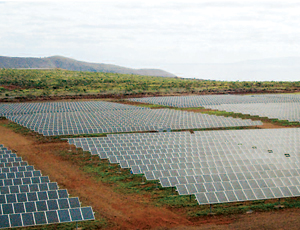Just over a year into a long-term partnership with the U.S. Dept. of Energy to transform Hawaii into a model clean-energy economy, 1,000 MW of alternative-energy projects are in the works along with an undersea-cable transmission project to deliver power among the state’s islands. One goal of the partnership is to offer Hawaii’s experience as a test bed for island economies globally as they make the transition to clean energy.

The Hawaii Clean Energy Initiative (HCEI) was launched in January 2008 with a memorandum of understanding between Hawaii and DOE. HCEI aims to produce 70% of the state’s energy using renewable resources by 2030. Fossil fuels provided nearly 91% of Hawaii’s electricity in 2007, and its average electric rate for all sectors that year was 21.29¢ per kilowatt-hour, the highest in the U.S., according to the Energy Information Administration. High energy costs are a common problem for island economies worldwide when they lack natural resources and must import fuel.
Expanding the renewable sector required a combined state and federal DOE focus on decoupling Hawaiian Electric Co.’s (HECO) profit model from one that inherently encourages energy usage and upgrading the power grid to handle variable generating sources. Key to the new distribution model is a 60-mile, 6-in.-dia undersea cable planned by the state to connect new energy sources with nearby islands. The project is in environmental review, with work three years away.
Preparing for the cable, Castle & Cooke Hawaii and Newton, Mass.-based First Wind each plan to develop 200-MW wind farms. Castle & Cooke’s Lanai project will use up to 200 2.5-MW turbines. The company just completed 10-acre, 1.2- MW La Ola solar farm on Lanai.
First Wind already owns and operates the 30-MW Kaheawa wind farm on Maui and has proposed to expand that by 27 MW. It plans to start construction in 2012 on 50 MW of the 200 MW total contracted with Hawaiian Electric Co., from the island of Molokai.
“People are blown away by the efficiency of our wind power,” says Theodore A. Peck, administrator of Strategic Industries Division for Hawaii’s Dept. of Business, Economic Development and Tourism. “Because the island location is windy, they run close to 50% of the time.”
The two wind farms and undersea cable could total $2 billion in construction costs, say officials.
To save the cost and liability of importing petroleum, Hawaii already produces 9.4% of its energy through renewables and hydropower. For example, a municipal solid-waste-recovery plant generates 46 MW from 2,160 tons of garbage per day, and the 30-MW Puna geothermal plant is powered by five production wells drilled deep into Kilauea Volcano. Both plants are expanding.
Reno, Nev.-based Ormat Technologies Inc. plans to go to bid in the next three months for installation of binary technology to capture energy from the wells’ 400°F hot water. The project would take a year to complete and produce an additional 8 MW of capacity. Honolulu-based Sopogy Inc. will complete a 500-kW demonstration Micro Concentrated Solar Power thermal trough project in June and has a contract to sell the energy to HECO. If successful, Sopogy hopes to build distributed micro-solar-thermal stations at many sites.
A planned 24-MW biofuel project by Hawaii-based Hu Honua Bioenergy LLC will convert a sugar mill’s powerplant that burned 225,000 barrels of oil a year to burn residual eucalyptus wood and green waste. The company has a term-sheet agreement with HECO and plans to begin operation in the next 18 months.
Ocean energy also is in the mix. A $250-million, 10-MW pilot Ocean Thermal Energy Conversion facility could lead the way to a larger $1-billion, 100-MW plant if it proves ocean temperature differentials can be efficiently exploited. A 2.7-MW wave-power platform developed by Australia-based Oceanlinx Ltd. could be operational by 2012. The floating platform captures air in a large cavity in the center as swells roll in. The compressed air pushes a reverse turbine that captures the energy on the in-stroke and the outstroke of the wave. “I like it for its simplicity,” says Karl Stahlkopf, HECO senior vice president of energy solutions.
In April the International Partnership for Energy Development in Island Nations announced the U.S. Virgin Islands will build on Hawaii’s success to explore geothermal and other indigenous energy sources.

Post a comment to this article
Report Abusive Comment